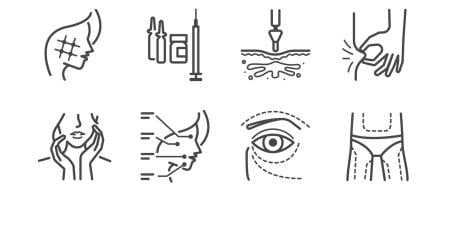Appearance and deformities are important to anyone who engages in social interaction. Teens as well as adults have valid cosmetic conditions that benefit from plastic surgery. Adolescent cosmetic surgery is not new, but the topic has come to the forefront as a result of recent media attention. The most common sources of information for teens about plastic surgery are magazines and television.1 The quick fixes on television "reality" shows can establish unrealistic expectations and distort the facts about actual plastic surgery.
Teens are often uncomfortable with their evolving bodies. Distortions in body appearance can lower self-confidence and disrupt social acceptance. This can result in difficulty with school, aggression, or withdrawal. The cosmetic procedures teens desire most to alter their appearance in ways that improve their self-confidence are liposuction, rhinoplasty, and breast augmentation.1
A major factor when considering an adolescent patient for plastic surgery is that the patient is still growing. The body itself is maturing, decision-making skills are evolving, and social skills are forming. Every analysis for potential surgery must weigh the following:
- Purpose for surgery: Is the proposed surgery realistic? Does the patient seem competent to make the decision to have surgery?
- Degree of deformity: Is the deformity noticeable? Are the patient's expectations for correction appropriate?
- Level of physical maturity: Will the patient grow out of the deformity?
- Social costs: Does the patient suffer socially because of the problem?
- The patient-parent decision: Are the parents supportive of the surgery? Are the parents pushing for the surgery against the patient's desires?
- Post-surgery patient attitude: Will the patient be able to adhere to a post-operative regimen?
To illustrate the application of these guidelines, I will discuss several common surgeries requested by adolescents and the factors important in each.
Rhinoplasty
Rhinoplasty (nose reshaping)2 is among the most requested surgical procedures for teenagers and, if done early, can prevent years of emotional distress. For a teenager concerned with appearance, a large or deformed nose in the center of the face gathers much attention. Rhinoplasty can be performed when the nose has completed most of its growth, which happens as early as 13 to 14 years in girls and about a year later in boys. When an unsightly nose is refined with cosmetic surgery, there can be a transformation in confidence, attitude, and demeanor.
For teenage nasal sculpture, one must evaluate the patient's purpose for surgery and ensure that the patient has realistic expectations. Enhancing the positives and subtracting the negative features are acceptable goals; trying to imitate a famous person's nose is not.
Gynecomastia: Male Chest Contouring Plastic Surgery
Gynecomastia, or female-sized breasts, is particularly distressing to males.3 Protruding breasts can result in mockery, social avoidance, and maladaptive behavior. Although gynecomastia can occur at any age, adolescents are particularly susceptible during their hormone changes.4 While most teenage gynecomastia resolves, that which has not resolved after 2 years typically will not. Many adolescents have stable gynecomastia problems; some have breasts that continue to grow. The problem affects each individual differently; a significant deformity can be subtle or massive in the patient's eyes. It takes very little breast tissue to make "puffy nipples" stick through a shirt or disturb a male chest contour.
Forcing a 13-year-old boy with C cup breasts to go to gym and play basketball shirtless can be cruel. The surgeon must weigh whether to perform surgery early and risk further growth or delay surgery and deal with the emotional problems due to large breasts. One must also balance the possible need for secondary surgery after further growth. I have treated many men, now independent and able to make their own decisions, who were angry that pediatricians kept saying their breasts would go away. In some of those cases, parents totally ignored the emotional stress of gynecomastia.
Female Breast Reduction
Some adolescent women suffer from massive breast size.5 Macromastia can result in pain from weight, awkward momentum, shoulder grooving, and social distress.6 An appropriate teenage breast reduction can result in an amazing transformation.
Making a teenager wait until her body further matures can be brutal. Early surgery, however, carries the risks both of further breast growth and a patient's decision about breast size that she regrets as an adult.
Otoplasty: Ear Cosmetic Plastic Surgery
Protruding or deformed ears can cause concerns for children and adolescents.7 Some do not want to, or cannot, wear their hair long for camouflage. Otoplasty is an option to bring projecting ears closer to the head, balance elements of the ear, or rebuild deformed components.8
The ear reaches almost adult size by the age of 5. Young children's cartilage is softer, resulting in an advantage for earlier plastic surgery. Firmer adult ear cartilage may need to be weakened during surgery, a potential distortion risk that can often be avoided in younger children. Projecting ears are a typical deformity often subject to much ridicule. External ear deformities are best treated before children start social interactions.
Inverted Nipples Cosmetic Surgery
Inverted nipples can be unattractive, causing distress for some adolescents.9 A major factor in the decision to pursue this surgery is the patient's gender. Although duct-sparing procedures can help lesser deformities, some nipple inversion requires that the ducts be surgically divided for correction. Duct division can result in a woman's inability to breast-feed. Hence, for some women, this surgery may be better postponed until adulthood. On the other hand, for a male teenager with nipple inversion from adherent gynecomastia tissue, gland and ducts have no function. Release of this adherent tissue and the subsequent change in the patient's chest sculpture can have a major positive emotional impact for him.
Losing Weight and Plastic Surgery
Liposuction can be valuable for sculpting tissue;10 it is not very useful for reducing weight. Removed fat cells are gone, but remaining fat cells can accumulate more fat. Teens therefore may better manage their weight loss by a change in habits, dieting, and exercise. Plastic surgery is better employed as a refinement tool.
In the maturing female teenager, body fat distribution is evolving. Many teens' body shape and habitus will change during the teenage years. A chubby teenager may grow in height and become a slim young adult. The degree of deformity must be balanced against advantages of waiting until the contour better defines itself.
Plastic Surgery after Massive Weight Loss
After a patient loses a large amount of weight, connective tissue fibers in the skin and fascia may be so stretched that folds of flesh remain.11 Although younger skin tends to shrink better than older skin, redundant folds can remain around the stomach circling around the back, the chest and breast region, thighs, arms, and neck. Plastic surgeries such as a tummy tuck, body lift, thigh lift, arm lift, or facelift are options.12
For an adolescent patient, the surgeon must balance the degree of deformity against further body growth filling in the loose skin. The patient's level of emotional distress and the concern for regaining of the weight must also be addressed directly and honestly.
Navel Cosmetic Surgery
The present popularity of the bare midriff style of dress exposes the belly button, a focal point of the abdomen.13 For a teenager, peer pressure and clothing choice can lead to stress over the appearance of the navel. The "outie" shape of the navel bothers many patients; it is difficult to adorn an "outie" with navel jewelry. Belly button umbilicoplasty can easily convert an "outie" to "innie" navel. Unlike nasal, ear, or breast problems, camouflage by clothing is an option for this condition.
The Parents
Although parents have the legal responsibility for their adolescents, the impetus for surgery needs to come from the patient. In elective cosmetic surgery, it should be the patient who is bothered by the problem and is looking for a solution, not the parents.
Conclusion
The deformity, physical and emotional maturity, and desired outcome for each adolescent patient must be carefully evaluated before any decisions are made. Additional consultations and long discussions before plastic surgery are often merited. Sometimes, however, the real question is: is it ethical not to operate on an adolescent patient?
References
- Pearl A, Weston J. Attitudes of adolescents about cosmetic surgery. Ann Plast Surg. 2003;50(6):628-630.
-
Rhinoplasty Nasal Plastic Surgery. Available at: http://www.plasticsurgery4u.com/procedure_folder/rhinoplasty_map.html. Accessed January 3, 2005.
-
Gynecomastia Male Chest Cosmetic Surgery. Available at: http://www.plasticsurgery4u.com/procedure_folder/male_breast/index.html. Accessed January 3, 2005.
-
Fitzgerald PA. Endocrinology. In: Tierney LM, McPhee SJ, Papadakis MA. Current Medical Diagnosis and Treatment. New York, NY: Lange Medical Books. 2005. Accessed February 25, 2005.
-
Female Breast Reduction. Available at: http://www.plasticsurgery4u.com/procedure_folder/breast_reduction/index.html. Accessed January 3, 2005.
-
Vasconez LO, Vasconez HC. Plastic and reconstructive urgery. In: Way LW, Coherty GM, eds. Current Surgical Diagnosis and Treatment. New York, NY: Lange Medical Books; 2003. Accessed February 25, 2005.
-
Otoplasty Ear Plastic Surgery. Available at: http://www.plasticsurgery4u.com/procedure_folder/ears/index.html. Accessed January 3, 2005.
-
Row LD. Otolaryngology: head and neck surgery. In: Way LW, Coherty GM, eds. Current Surgical Diagnosis and Treatment. New York, NY: Lange Medical Books; 2003. Available at:http://online.statref.com/. Accessed February 25, 2005.
-
Inverted Nipple Plastic Surgery. Available at: http://www.plasticsurgery4u.com/inverted_nipple/index.html. Accessed January 3, 2005.
-
Liposuction Plastic Surgery. Available at: http://www.plasticsurgery4u.com/procedure_folder/liposuction/index.html. Accessed January 3, 2005.
-
Plastic Surgery after Massive Weight Loss. Available at: http://www.plasticsurgery4u.com/a/after_weight_loss/index.html. Accessed January 3, 2005.
-
Tummy Tuck Abdominoplasty. Available at: http://www.plasticsurgery4u.com/procedure_folder/abdominoplasty/index.html. Accessed January 3, 2005.
-
Belly Button Umbilicoplasty. Available at: http://www.plasticsurgery4u.com/belly_button/index.html. Accessed January 3, 2005.



